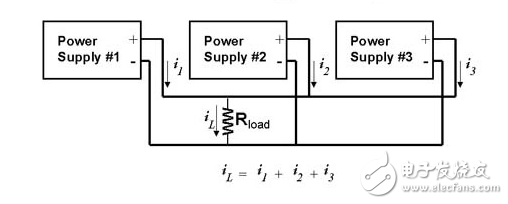
资料下载

正确配置电源并联分担负载电流或风险的系统故障
正确配置电源并联分担负载电流或风险的系统故障
设计师并联连接电源,以获得总输出电流大于从一个单独的供应,以及提供冗余,提高可靠性,避免PCB热问题,提高系统效率。然而,如果工程师没有正确地配置这些并联系统共享负载电流,电源可以关闭之前,所需的电流传递,导致系统故障
这可能对系统故障只与逐渐增加的电流要求存储卡的逐步提高,DSP和ASIC,所有这些通常与较低的电源电压很高的直流电流。这些高性能半导体器件的负载电流也要求非常快的变化

Figure 1: Three power supplies connected in parallel to produce additional current. The total output current is the sum of the output currents of the individual power supplies. (Source: Keysight Technologies)
There are several other good reasons to employ a parallel power architecture (Figure 1):
Reliability and Redundancy. Using multiple small power supplies can be more reliable than using a single large power supply. Continuously operating a power supply at maximum load significantly reduces its reliability and shortens its life. Redundancy is important in mission-critical systems such as military or medical applications where failure of one module cannot be allowed to affect the entire system. In situations where a product or system cannot tolerate any downtime, “N + 1 redundant” systems use a number of small supplies where N units are needed to power the load, but a “+1” supply is added for redundancy.
Efficiency. If the power system must support widely ranging loads, efficiency can be optimized by adjusting the number of operating supplies to the load. For example, a DC/DC converter formed by two supplies running at half capacity can have better overall conversion efficiency than a single supply running near full capacity.
Thermal Management and Lifespan. Using two or more lower-power modules to produce higher output power also helps to distribute the thermal load, thereby avoiding hot spots on the board. If two supplies source half of the load current, each will get only half as hot as they would not be shouldering the complete load. Spreading the supply heat also puts less thermal stress on components, extending each supply’s lifetime.
声明:本文内容及配图由入驻作者撰写或者入驻合作网站授权转载。文章观点仅代表作者本人,不代表电子发烧友网立场。文章及其配图仅供工程师学习之用,如有内容侵权或者其他违规问题,请联系本站处理。 举报投诉
- 相关下载
- 相关文章





